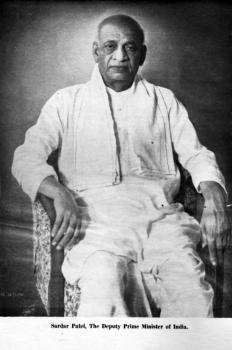
Iron Man Builds A Nation
Between the years 1947 and 1949, 565 princely states were integrated to join the Indian Union in record time.
Four people were at the forefront of the process of building the nation after the British had handed over the reins of the administration to the Indian government. Sardar Patel and along with him were Lord Mountbatten, Jawaharlal Nehru, and V.P. Menon. These were very difficult times as the turmoil of Partition had created bitter memories and an atmosphere of distrust.
Several princely states sat on the fence acceding neither to India nor Pakistan till the hour of freedom. Some like Hyderabad, one of the richest states in the heart of India, harboured dreams of complete independence. Pakistan also had an eye on it. If Hyderabad had acceded to Pakistan, a piece of Pakistan would have been within the territory of India.
During this period, Patel was also Deputy Prime Minister, Home Minister and Minister in charge of Information and Broadcasting. When Nehru travelled aborad, Patel also took charge as the Acting Prime Minister. He was also a member of the Constituent Assembly that had taken upon itself the monumental task of drafting a Constitution for the nation.
In the midst of such multiple challenges and bearing such huge responsibilities, Patel held his head above the water and continued to swim past the roaring tide to build a nation. The geography of India with territorial and administrative continuity and integrity would not have been but for this man's vision and perseverance. He lent his iron will and steely determination to create India.
It is hence that we know him as the Iron Man of India.
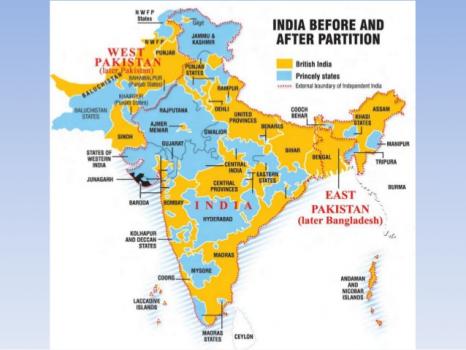
Choice of India or Pakistan for the Princely States
The Princely states that formed two fifths of the territory of India had the choice of joining either India or Pakistan at the time of Independence. They also had the option of joining neither.
While rulers of several states made the choice depending on geography and demographics, the Rajas of some states like Jodhpur and Bhopal were unable to decide till the very end. Travencore and Hyderabad nursed dreams of remaining independent. Junagadh acceded to Pakistan and then reverted to India after its eccentric Nawab fled to Karachi. Pakistan attacked Kashmir in the midst of this fracas while its Raja signed the instrument of Accession in favour of India.
The imprint of Sardar's firm hand, remarkable foresight and tactful diplomacy is clearly seen in the result that ensued. 565 states acceded to India.
This map shows the various Princely states at the time of Independence and Partition.
Patel describes the monumental work of integrating the Princely States into the Union of India
"When I was sworn in as Home Minister, I did not expect to get the work of integrating Princely States" says Patel as he shares his experiences in this audio clip recorded on 4 November 1948 in Nagpur.
To those who were undecided, Patel was willing to give more time. "Mera ek riyasat ke saath kaam nahi hai. Choti moti bahut sari riyasaton ke saath kaam hai. Agar yeh kaam jaldi na hoga to koi rukawat kaam ko bigaad dega." he says describing his approach toward the monumental task.
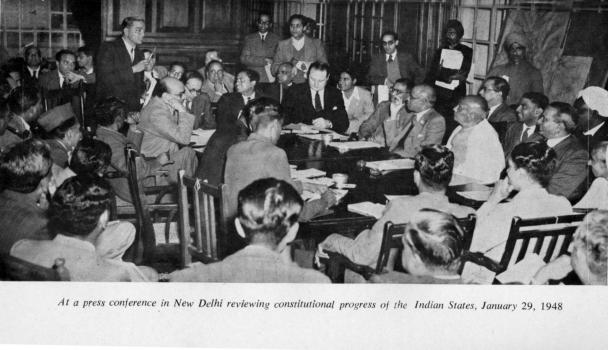
States Ministry formed under Sardar Patel
'It seemed to be from Sardar's remark that Nehru was probably skeptical about the success of the plan. Nor was the Sardar himself over-optimistic. For one thing, he was doubtful whether we could get the accession policy implemented in the few weeks before 15th August; but, as I suggested to Sardar, the very shortness of time might work to our advantage.' writes Menon in his book 'The Integration of Indian States'.
At a meeting on 25th June, 1947, the Cabinet of the Interim Government had accepted the proposal for creation of the States Department to oversee the matter of Accession of States. This department was allocated to Sardar Patel and V.P. Menon was appointed it's Secretary.
Menon had suggested that in view of the disposition of some rulers to join Pakistan or to remain independent, perhaps some organic bond ought to be forged between the Government of India and the states to preserve the integrity of the nation. He recommended that the States be asked to accede only on matters of Defence and External Affairs as the rulers would not see this as a loss of rights enjoyed by them. The subject of Communications was added to these two items in the draft of the Instrument of Accession drawn up by the Department.
There were hundreds of princely states, some large, some small, scattered across the length and breadth of the country. The task at hand was monumental. And time was running out fast.
Seen in this photograph is Sardar Patel at a Press Conference held in New Delhi with Mr. V. P. Menon, Secretary of the Ministry of the States sitting to his right.
Countries within a Country!
565 Princely States had accepted British sovereignty. On 15th August, 1947, when the British would leave, with the Lapse of Paramouncy, these states would be free again.
As a result, India would be a set of countries within a country. A recipe for chaos, civil war and disaster.
One man took up the task of averting that disaster. This audio describes the situation of the Indian Union before its unification by Sardar Patel.
The Approach to Accession
This audio clip describes the situation of the Princely States and the process that was adopted by Sardar to get the kings and nawabs to accede to India.
He agreed to allow the rulers to retain their ranks, title and Privy purses asking in return that they sign the Instrument of Accession by which the Government of India would take over matters of Defence, International Relations and Communication in respect of the state.
For Sardar Patel, the geographic and constitutional integrity of the nation was priceless.
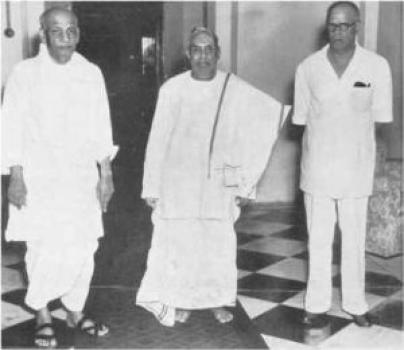
Sardar Patel and V.P. Menon : A Formidable Force
'Sardar Patel never interfered in my work. I did my job in the full knowledge that I had his authority to carry out his policy. He accepted my views on most matters; if he disagreed, he would tell me so. We would then discuss and argue the issue, and if I succeeded in convincing him of the correctness of my view he would readily accept it. I have never seen him swayed by considerations of prestige' said V.P. Menon speaking of his long association with Sardar Patel.
Patel was known to be an astute judge of people. Placing complete faith in his team, he had a great ability to delegate responsibility. So while he formulated policy and played an active part in negotiating with the rulers of Princely states, he trusted Menon and other Ministry officials in matters of implementation.
Forming a formidable partnership, these two men managed to secure the accession of 565 princely states into the Union of India in record time. Never before in history had the task of Integration of a Nation been accomplished so swiftly and efficiently.
Here Sardar Patel and V. P. Menon are seen with the Maharaja of Cochin.
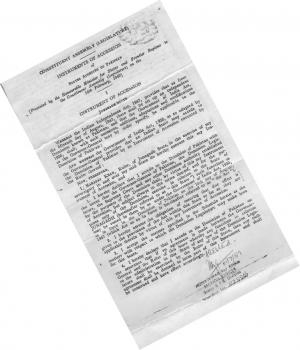
Twist in the Tale : Junagadh Accedes to Pakistan
On 15th August, 1947, in an unexpected twist in the saga of Accession, the Nawab of Junagadh acceded to Pakistan.
The decision was not communicated to the Government of India. The first intimation those in the Government had was when it was reported in the newspapers of 17th August.
This became a source of great worry for India as Junagadh was in the middle of Kathiawar that was a part of India. Moreover, Junagadh had a Hindu majority. The eccentric Nawab whose chief preoccupation had been with the hundreds of dogs that he owned had all along indicated his intention toward a united Kathaiwar. In the very last moment, he had backtracked.
The rulers of the other states in Kathiwar condemned the accession of Junagadh to Pakistan and requested the Nawab to reconsider his decision. To this the Nawab replied "The Indian Independence Act did not and does not require a ruler to consult his people before deciding on Accession. I think we are making an unnecessary fetish of the argument of geographical continuity. Even then, this is sufficiently provided by Junagadh's sea coast with several ports which can keep connection with Pakistan"
The other states of Kathaiwar urged the Government of India to take immediate steps to ensure the continued protection of Kathiawar. If the administration did nothing, they said, the people of Kathiawar would lose faith in the will and ability of the newly formed government. Patel, Nehru, Mountbatten and Menon met to discuss the way forward. The situation in a small princely state had blown over into a raging storm.
Junagadh signs the Instrument of Accession in favour of Pakistan
The story of the accession of Junagadh is the most interesting chapter in the saga of the integration of Princely states. Nawab Sir Muhammad Mahabat Khanji, ruler of Junagadh state, first signed the Instrument of Accession in favour of Pakistan thereby acceding Junagadh to Pakistan. But that was not to be.
The story of Junagadh
The Princely state of Junagadh was ruled by an eccentric Nawab who once declared a state holiday to celebrate the wedding of his pet dogs!
Junagadh had a Hindu majority and the Nawab gave signs of acceding to India. But on 15th August, 1947, he signed the Instrument of Accession in favour of Pakistan. It came as a shock to many as Junagadh had no physical continuity with Pakistan and was situated in the midst of other states of Kathiawar that had already acceded to India.
Gradually, events unfolded in such a manner in Junagadh that eventually, the Nawab fled to Karachi and his Dewan Shah Nawaz Bhutto followed him soon thereafter, handing over the reins of the administration to the Government of India.
This audio clip describes the interesting story of Junagadh and how with the efforts of Sardar Patel, the state was finally integrated into the Indian Union.
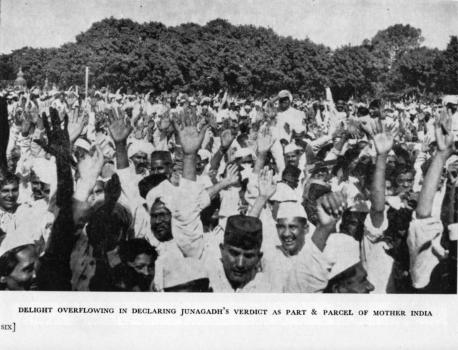
Referendum at Junagadh
Visiting Junagadh on 13th November, 1947, Sardar Patel announced that the Government of India would abide by the wishes of the people of Junagdh. After having signed the Instrument of Accession in favour of Pakistan, the Nawab had fled along with his beloved dogs. Shah Nawaz Bhutto, the Dewan of Junagadh had also left for Karachi after handing over the reins of the administration of the state to the Government of India.
Hence, as promised, a plebiscite was held in Junagadh on 20th February, 1948. Out of the total number of 2,01,457 registered voters, 1,90,870 exercised their franchise. Out of this number, only 91 cast their votes in favour of Pakistan.
At the same time a Referendum was also held in minor states of Mongrol, Manavadar and others that the ruler of Junagadh had claimed as his feudatories. After this historic verdict Junagadh became a part of the Union of India.
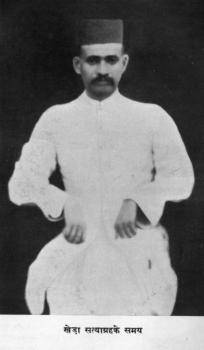
A life-changing decision
Despite initially dismissing Gandhi's methods, Patel was drawn to Gandhi. The successful barrister dressed in a western suit and speaking mainly English, did not envisage a life of satyagraha when he first encountered the Mahatma. But something began to churn within him after watching Gandhi closely.
Speaking of Vallabhbhai's decision to leave his practice and join the path of satyagraha, Gandhi said 'Vallabhbhai told himself "No doubt my practice is flourishing today. I am also doing something big in the municipality. But the struggle for the peasants in Kheda is bigger than that. My practice may or may not be there tomorrow. My money will be blown tomorrow; those who inherit my money will blow it. Let me leave them a higher legacy than money.'
Giving up his ambitions and dreams, Patel followed in the footsteps of the Mahatma nursing the cherished desire of freedom. 'I took to this life after mature consideration and not on the spur of the moment' he said of his decision.
This decision altered no doubt his own life. But it altered also the destiny of the nation.
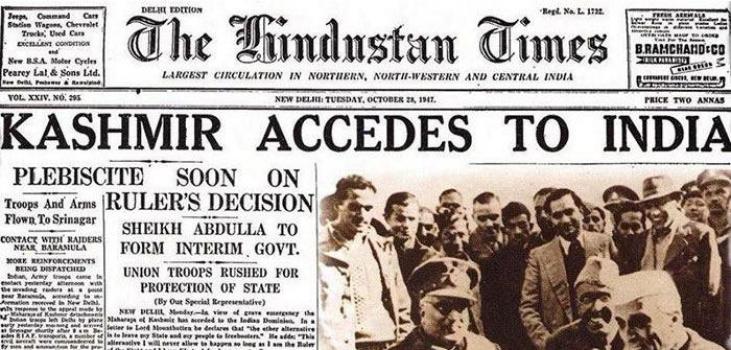
Kashmir Accedes to India
In the saga of Accession, the story of Kashmir was one of the most interesting. Nehru had a special attachment to it and Jinnah coveted it as well.
Politically, Kashmir had a Hindu Raja as its ruler while its three regions of Jammu, Kashmir and Ladakh had a Hindu, Muslim and Buddhist majority respectively. As a result Raja Hari Singh had been sitting on the fence acceding neither to India nor to Pakistan till the date of Independence.
On 22nd October, 1947 about 5000 armed tribesmen from Pakistan attacked Kashmir and were marching toward Srinagar. Several members of the Raja's military deserted the army, some even defecting to the other side. The Raja made a desperate appeal to the Government of India to come to his aid. Lord Mountbatten questioned how India could send its soldiers to defend a state which had not joined it. Sheikh Abdullah, who had just been released from jail by the Maharaja and Mahajan, the Prime Minister of Kashmir both urged Nehru to send Indian soldiers for the defence of Kashmir. While Nehru was unable to make up his mind, Patel pursuaded him with his decisiveness and clarity.
The Government decided to send the Indian army to the aid of Kashmir. The next day Maharaja Hari Singh signed the Instrument of Accession in favour of India.
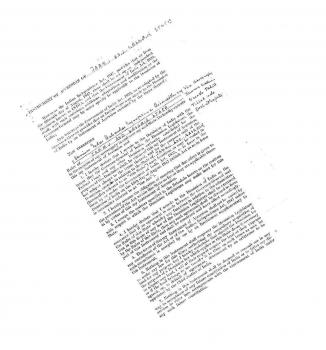
Instrument of Accession(Jammu and Kashmir State)
Raja Hari Singh, the ruler of Kashmir, signed the Instrument of Accession of Jammu and Kashmir State in favour of India on 26th October, 1947.
Upon the signing of this Instrument by the Raja, the princely state of Jammu and Kashmir became a part of India.
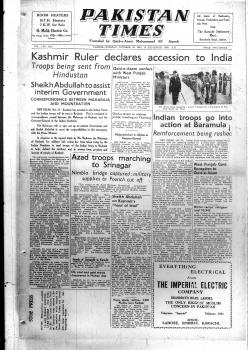
Kashmir accedes to India
As the story of Accession unfolded and the date of Independence neared, Kashmir's fate still remained undecided. The state had a Muslim majority. However, its ruler Raja Hari Singh was Hindu. Moreover, the area of Jammu had a Hindu majority and Ladakh had a Buddhist majority. Fearing a backlash from his people with any decision he took, the Raja remained ambiguous.
In October, tribal raiders from Pakistan began to enter Kashmir in breach of the Standstill Agreement. On 22nd October, 1947, the raids escalated into an all-out invasion with about 5000 armed tribesmen from Pakistan entering Kashmir in 300 lorries carrying surplus arms and ammunition. On the very same day, the town of Muzzafarabad was seized and burnt. On 24th October, the raiders captured the powerhouse of Mahura and switched off electricity to the capital city plunging Srinagar into darkness. Fearing the worst, Maharaja Hari Singh sent a desperate appeal for help to the Government of India.
The Government of India sent V.P Menon to Srinagar to assess the situation before taking a decision. 'The Maharaja was completely unnerved by the turn of events and by his sense of lone helplessness' says Menon speaking of his visit. The Prime Minister of J&K apprised Menon of the perilious situation and once again pleaded with the Government of India to come to the rescue of the State. Returning to Delhi, Menon conveyed the gravity of the situation to the Defence Committee which decided on sending assistance to Kashmir provided the Maharaja acceded to India.
This newspaper clip from the Pakistan Times informs its readers about Maharaja Hari Singh signing the Instrument of Accession acceding Kashmir to the Union of India.
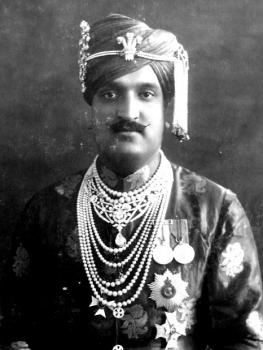
Maharaja Hari Singh
Maharaja Hari Singh of Kashmir ruled over this northern state which bordered Tibet, China and Afghanistan. While Jammu had a Hindu majority, Muslims were the majority in Kashmir and Ladakh had a Buddhist majority. As a result, the Maharaja was unable to decide on whether to join India or Pakistan, fearing a retaliation from a section of his people with any decision that he took.
After much indecision and drama, the Maharaja finally acceded Jammu and Kashmir to India in September, 1947.
The story of Jodhpur
To entice the Raja of Jodhpur to join Pakistan, Jinnah had given the ruler a blank sheet of paper signed by him, asking the Raja to enter therein any conditions that he may want in order to accede to Pakistan. Despite the attractive offer, the Raja was unable to decide. Realising that India might lose Jodhpur to Pakistan, V.P. Menon met the Maharaja for discussions. In the heat of the negotiations, the Maharaja pulled out his pistol at Menon, who remained remarkably calm and composed through it all.
Finally, the Raja signed the Instrument of Accession in favour of India and Jodhpur integrated into the Indian union.
This audio clip narrates the story of Jodhpur.
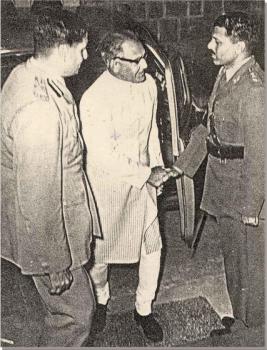
Nawab of Bhopal arrives for discussions about accession
'Quite candidly, I do not look upon the accession of your State to the Indian Dominion as either a victory for us or defeat for you. It is only right and propriety which have triumphed in the end, and in that triumph you and I have played our respective roles.' wrote Sardar Patel to the Nawab of Bhopal after the state had acceded to India.
Initially, Nawab Hamidullah of Bhopal was strongly opposed to accession. He did not wish Bhopal to become a part of either India or Pakistan and expressed his desire to enter into treaty relations with both nations. But by early August, it dawned on the Nawab that a vast majority of rulers had acceded to one of the two Dominions and his position was growing increasingly untenable. The Nawab asked for an alteration in the conditions for accession. He was informed that conditions for all states would remain the same. At last, the Nawab signed on the dotted line.
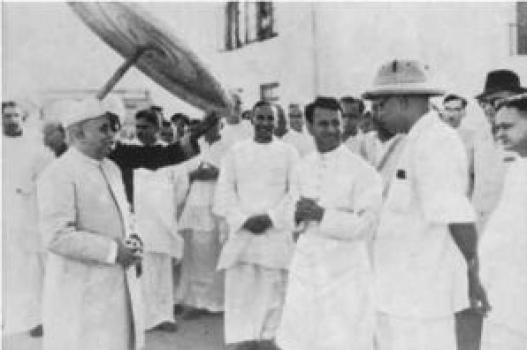
Travancore comes on board
Travancore had announced that it would assert its right to remain independent. This was cause for anxiety as it was expected that this announcement would cause repercussions and encourage other rulers to follow suit. When an invitation for a meeting of states rulers was sent to the Raja of Travancore, the Government of the state replied that there was no point in their representatives attending the meeting as they had already decided not to accede to India.
V.P. Menon urged C.P.Ramaswami Aiyar, the ruler of Travancore to reconsider his decision. Lauding him for his past contribution toward the nation, Menon told the Aiyar that it ought not to be said that the Raja had not made a contribution toward building a united nation when he had it in his power to do so. The Raja asked for more time to think the matter over.
Finally, the Raja acceded Travancore to the Union of India. V.P. Menon believes that this decision had a distinct impact on other rulers who were still undecided and wavering.
In this image, the Maharajah of Travancore is seen with the Maharajah of Cochin at Trivandrum.
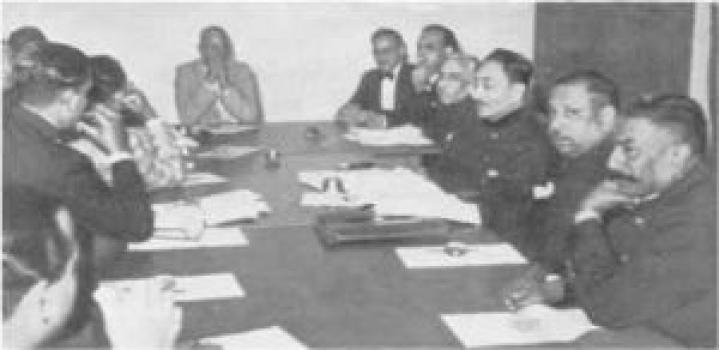
Menon in the midst of unending negotiations
'I had never expected that I would see freedom for India in my lifetime. Since that had materialized, my life's ambition was achieved. Further I had been overworked and was feeling the strain. I had not taken a rest for many years' says Menon in his book 'The Integration of Indian States' in respect of the offer made to him by Sardar Patel to take up the Secretaryship of the States Ministry. He conveyed to Sardar that he had planned to retire from Government Service after 15th August 1947.
Patel responded saying that this was no time for people like him to think of rest or retirement. That he ought to consider it his bounden duty to work for the consolidation of freedom. Putting nation ahead of personal interests, at just this one direction from Sardar, Menon came on board to accept the secretaryship of the States Ministry. Together with Sardar Patel, Menon played an instrumental role in the integration of 565 princely states into the Union of India in such a short span of time.
This photograph shows V. P. Menon conferring with the rulers of states in Orissa as a part of several meetings he held with rulers across India in connection with Accession.
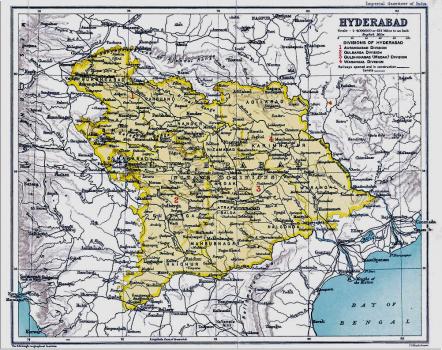
The story of Hyderabad, Premier State of India
While Junagadh was the pawn and Kashmir the queen, Hyderabad occupied the place of king in the dynamics of accession that took shape between India and Pakistan.
Geographically, Hyderabad was in the heart of Indian territory. Economically, it was a premier state. The state had its own coinage, currency and stamps.
The Nizam of Hyderabad declared through a firman issued by him, that on 15th August, 1947, Hyderabad would become neither a part of India nor a part of Pakistan. It would remain an independent sovereign.
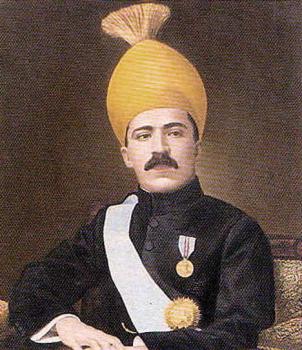
Nizam of Hyderabad seeks sovereignty for state
Nizam Mir Usman Ali Khan Bahadur of Hyderabad declared through a firman issued by him that upon Independence, Hyderabad would accede neither to India nor to Pakistan. That it would remain an independent sovereign.
Hyderabad was located geographically in the heart of Indian territory. Economically, it was a premier state with an annual revenue of Rs. 26 crores. It had a large population of sixteen million people. The States Ministry took measures to negotiate with the Nizam's representatives pressing upon them the mutual advantage that would accrue to both Hyderabad and India if the Nizam acceded to India. The Nizam's representatives communicated his inability to take that decision and even said that if pressed too hard, the Nizam would consider acceding to Pakistan.
Ultimately, these threats failed and Hyderabad acceded to India.
This is an image of the Nizam of Hyderabad, Mir Osman Ali Khan Bahadur.
The Story of Baroda
Sir Pratap Singh Gaekwar, the ruler of Baroda, was one of the first to sign the Instrument of Accession acceding his state to India. But soon thereafter, he began to have second thoughts.
On 15th August, 1947 when the Nawab of Junagadh acceded to Pakistan, consequently pushing Kathaiwar into a state of turmoil, the ruler of Baroda sensed a chance to gain special advantages for himself. Writing to the States Ministry, he offered to help in resolving the issue of Junagadh if Baroda was given jurisdiction over Palanpur, Rewakanta and four other areas in Gujarat. He also sought in return for his help, that the ruler of Baroda be declared King of Gujarat and Kathiawar.
Sardar Patel sent him a plain reply. The Government of India, he said to the Raja of Baroda, did not need his help.
This audio narrates in brief the history of the Princely State of Baroda and describes how the chapter of Accession unfolded in the state.

Baroda accedes to India, then bargains for more
Sir Pratap Singh Gaekwar, the ruler of Baroda, was one of the first to Sign the Instrument of Accession acceding his state to India.
However, when the Nawab of Junagadh acceded to Pakistan, he began to sense that he could use the situation of turmoil in Kathiawar to bargain for more. With an eye on obtaining special advantages for himself, the Raja offered to help in resolving the issue of Junagadh if Baroda was given jurisdiction over Mahikanta, Rewakanta, Sabarkanta, Palanpur, Western India States and Gujarat States in Gujarat along with the power the Dominion Government had over them. He also sought in return for his help, that the ruler of Baroda be declared King of Gujarat and Kathiawar, so as to have sovereign powers.
Sardar Patel would have none of this. Responding to the Raja of Baroda, he said that the Government of India did not need his help.
In this photograph Sardar Patel is seen with the Maharaja of Baroda and Dr. Jivraj Mehta, head of the Interim Ministry in Baroda.
New System for a New Nation
The British had set up an efficient system of administration in India. When they left, a number of British officers returned to England. Several Muslim officers in the administration moved to Pakistan. As a result there were gaps in ensuring a smooth continuity of the administrative system. In these circumstances, Sardar Patel envisioned an Indian Administrative Service cadre along the lines of the Indian Civil Services that existed before and created a special recruitment board for the purpose. He also began to build and strengthen democratically elected councils and peoples representatives. Over 75,000 soldiers of the armies of the erstwhile Princely States were amalgamated into the Indian army.
Gradually, the Princely States that had acceded to the Government of India on matters of Security, International Relations and Communications came to be totally integrated into the nation on all matters.
This audio clip describes some of the challenges that Sardar Patel faced as the First Home Minster of Independent India and the work he undertook to create new systems for the new nation.
The Story of the Integration of the Indian States by V. P. Menon
'This book is in part fulfillment of a promise made to the late Sardar Vallabhbhai Patel. It was his earnest desire that I should write two books, one narrating the events leading to the transfer of power and the other dealing with the integration of the Indian States' writes V.P. Menon in the Preface to his book 'The Integration of the Indian States' in which he gives a first person account of the monumental task of accession and integration that he accomplished as part of a team led by Sardar Patel.
'I have taken up the integration of the States first, because the events of the four hectic years, 1947 to 1951, are so vivid in my memory. Today, we think of the integration of the States only in terms of the consolidation of the country, but few pause to consider the toils and anxieties that had to be undergone till, step by step, the edifice of a consolidated India was enshrined in the Constitution. It was a co-operative effort in which everyone from Sardar - our inspiration and light - down to the rank and file played his part. The entire staff of the States Ministry, both at New Delhi as well as the regional headquarters, threw themselves heart and soul, into the task. There was a unity of purpose animating everyone. They are the unsung heros who made possible the consolidation of the country.' Menon continues to say in the Preface to the Book.
Sardar : Pied Piper of the Princes
Sardar Patel took over the reins of the States Ministry a few months before India was to attain Freedom and began approaching rulers of the Princely States to accede to India.
The rulers of several states followed his lead. This cartoon Image entitled 'They Toil' shows Sardar Patel as the Pied Piper followed by the rulers of various princely states who follow his leadership in acceding their state to India.
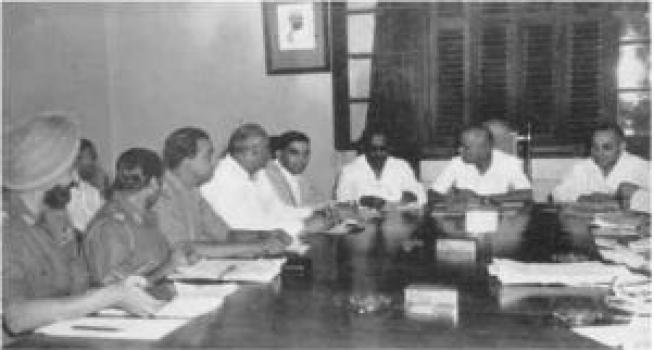
None can segregate us into segments
'We ask no more of the States than accession on these three subjects in which the common interests of the country are involved. In other matters, we would scrupulously respect their autonomous existence.
This country...is the proud heritage of the people who inhabit it. It is an accident that some live in the States and some in British India...None can segregate us into segments... I suggest that it is better therefore for us to make laws sitting together as friends than to make treaties as allies.
I invite my friends the rulers of States and their people to the councils of the Constituent Assembly in this spirit of friendliness'
So said Sardar in his policy statement made on 5th July 1947 to reassure the princes and rulers of the princely states to accede to India on the three matters of Security, International Relations and Communications.
This photograph is taken at a conference of Rajpramukhs convened by the States Ministry to discuss the issue of accession.
Sab Ek Samaan
'Koi Unch nahi, Koi Neech nahi. Sabhi Ek Samaan hai.' says Sardar Patel in this speech beseeching all Indians to come together to build a strong nation.
There is no pure, no impure. No high nor low. We are all equal says Patel as he asks Hindus,Muslims, Parsis, Christians and Sikhs to unite as Indians leaving aside their differences.
This speech urging the people of India to move toward national unity, continues to hold great value even half a century later.
-

Iron Man Builds A Nation
-

Choice of India or Pakistan for the Princely States
-

Patel describes the monumental work of integrating the Princely States into the Union of India
-

States Ministry formed under Sardar Patel
-

Countries within a Country!
-

The Approach to Accession
-

Sardar Patel and V.P. Menon : A Formidable Force
-

Twist in the Tale : Junagadh Accedes to Pakistan
-

Junagadh signs the Instrument of Accession in favour of Pakistan
-

The story of Junagadh
-

Referendum at Junagadh
-

A life-changing decision
-

Kashmir Accedes to India
-

Instrument of Accession(Jammu and Kashmir State)
-

Kashmir accedes to India
-

Maharaja Hari Singh
-

The story of Jodhpur
-

Nawab of Bhopal arrives for discussions about accession
-

Travancore comes on board
-

Menon in the midst of unending negotiations
-

The story of Hyderabad, Premier State of India
-

Nizam of Hyderabad seeks sovereignty for state
-

The Story of Baroda
-

Baroda accedes to India, then bargains for more
-

New System for a New Nation
-

The Story of the Integration of the Indian States by V. P. Menon
-

Sardar : Pied Piper of the Princes
-

None can segregate us into segments
-

Sab Ek Samaan